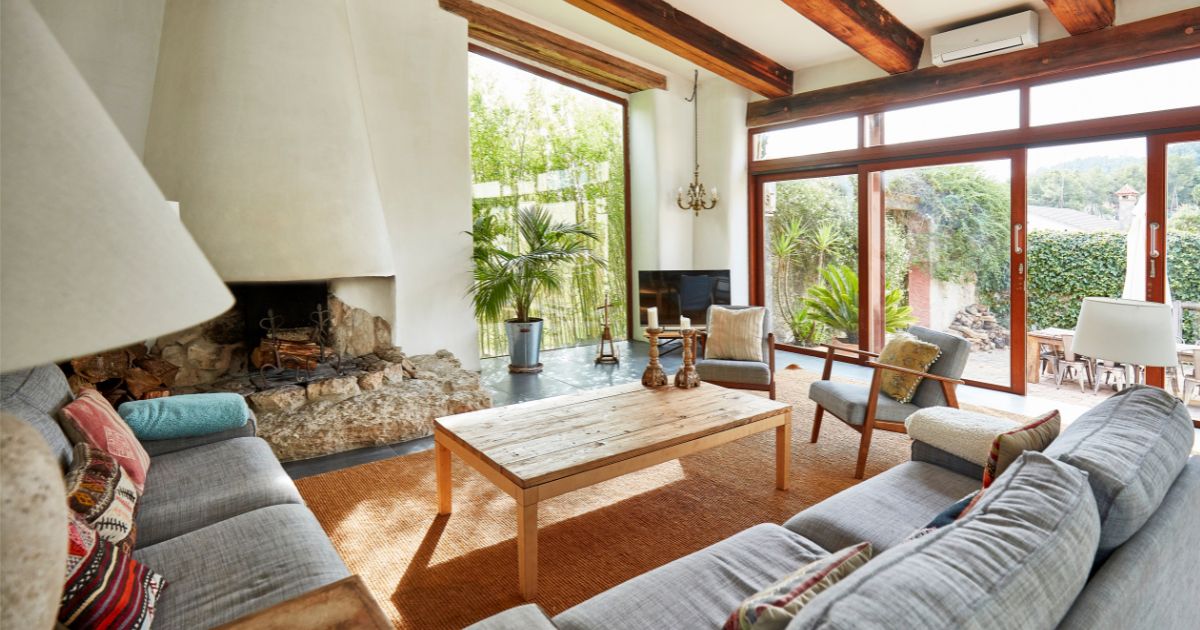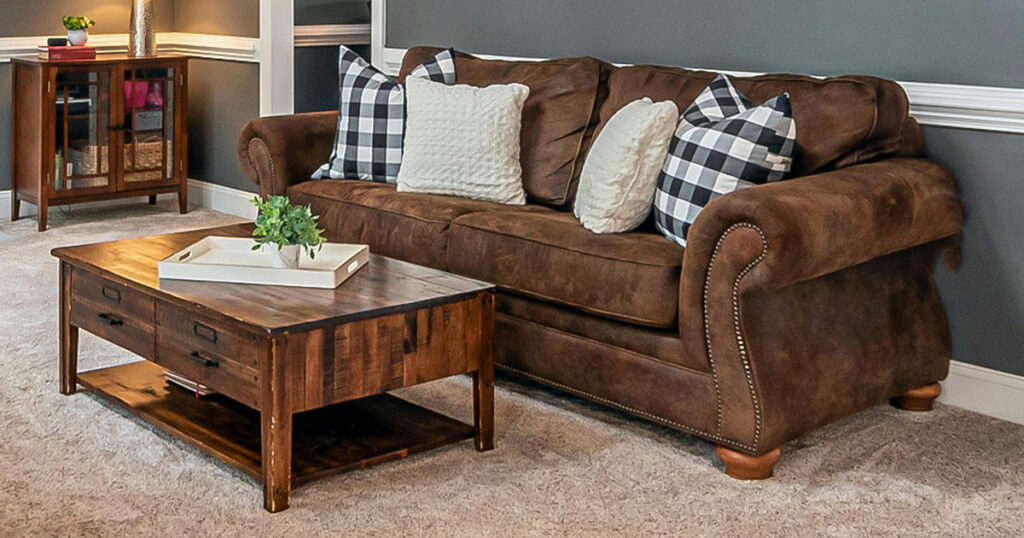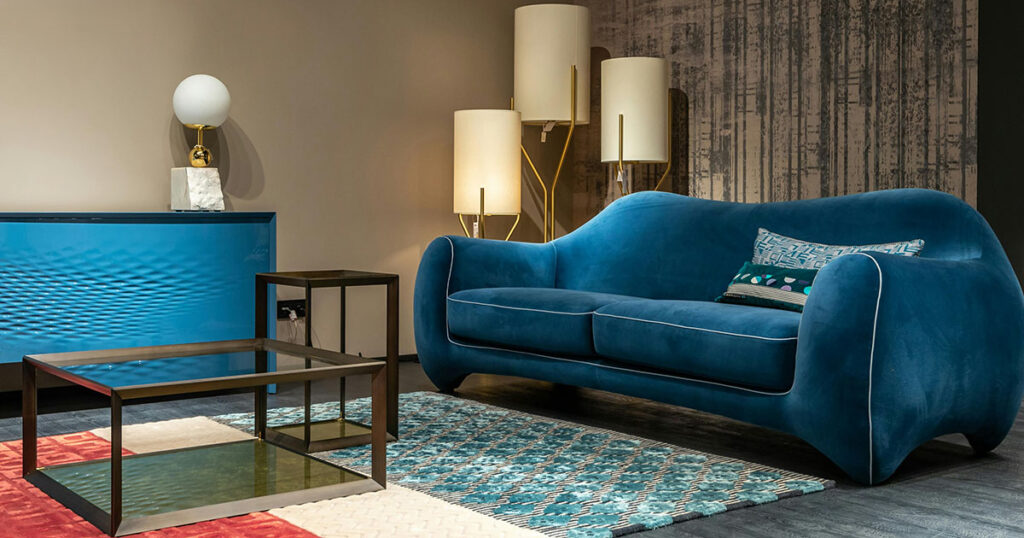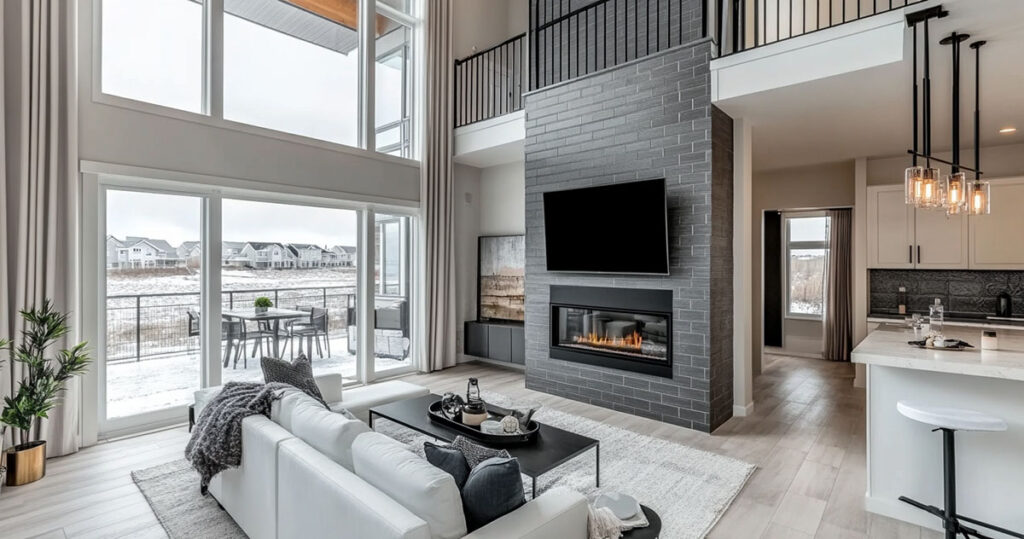Selecting the right rug can transform your modern farmhouse space from merely nice to absolutely stunning.
A well-chosen rug anchors your furniture, adds warmth, and ties together your carefully curated neutral palette.
Whether you’re decorating a cozy home or a commercial space with farmhouse flair, this guide will help you select the perfect rug that balances beauty and function.
Understanding Modern Farmhouse Style
Modern farmhouse style blends traditional rustic elements with clean contemporary design. This popular aesthetic creates spaces that feel both fresh and familiar – cozy without being cluttered.
The style celebrates natural materials like wood, stone, and metal, balanced with soft textiles. Furniture tends to be comfortable and inviting, encouraging gatherings and conversation.
Throughout these spaces, you’ll find a mix of modern pieces alongside vintage or antique finds that add character and history.
What makes modern farmhouse unique is its balanced approach – taking the warmth of traditional farmhouse style but eliminating excess ornament for a cleaner, more contemporary look.
Color Selection: Creating the Perfect Palette
Modern farmhouse interiors typically feature a calm, neutral color palette that sets a serene and inviting tone. When selecting a rug, stick to colors that complement this established palette.
Neutrals and Earth Tones
The foundation of farmhouse color schemes includes whites, creams, beiges, tans, and grays. These colors create a bright, airy backdrop that lets architectural details and wood textures stand out.
For rugs, neutrals are a safe and stylish choice. An ivory, beige, gray, or greige rug will blend seamlessly with wood floors and neutral furniture, creating a unified, open feeling.
Accent Colors
While neutrals dominate, don’t shy away from soft accent colors in your rug. Look for faded or subdued versions of:
- Soft blues reminiscent of sky
- Sage or olive greens that echo foliage
- Buttery or mustard yellows like wheat fields
- Muted rust tones or barn red
These gentle color additions should appear weathered or sun-faded rather than bright and saturated. They can beautifully connect your rug to small accessories throughout the room.
High-Contrast Options
Another farmhouse-friendly approach is choosing a rug with high-contrast details in black or dark gray. A cream rug with black geometric patterns can look very modern farmhouse, with the dark pattern echoing black metal accents like light fixtures or door handles throughout the room.
Patterns That Enhance Farmhouse Style
The pattern of your rug significantly influences how well it complements your farmhouse interior. Generally, farmhouse style favors classic or understated patterns rather than ultra-modern or loud contemporary prints.
Faded Vintage Patterns
Rugs with subtle, vintage-inspired patterns bring a sense of history into your space. Consider distressed oriental or Persian-style rugs in neutral or muted colorways. The botanical motifs or medallion designs, when rendered in washed-out hues, deliver a timeless look that doesn’t feel too formal.
Classic Plaids and Stripes
Plaid or striped rugs nod to farmhouse’s country roots. A simple tan-and-cream plaid wool rug or a subtly striped cotton rug brings pattern in a tailored, familiar way. These patterns are often seen in other farmhouse textiles, so using them on the floor continues the theme.
Simple Geometrics
Geometric designs work in modern farmhouse spaces as long as they’re not too busy or ultramodern. Look for simple, classic geometrics like a Moroccan trellis pattern in neutral tones. Rugs with herringbone, chevron, or diamond weaves add subtle pattern through texture.
Nature-Inspired Motifs
Since farmhouse style celebrates bringing the outdoors in, rugs featuring botanical or nature-inspired patterns can reinforce that connection. Consider rugs with subtle leaf or vine motifs in subdued colors that complement your overall palette.
Texture: The Secret Ingredient
In modern farmhouse interiors, texture is just as important as pattern or color. Farmhouse style celebrates tactile elements, and your rug is a prime opportunity to introduce rich texture underfoot.
Natural Fiber Textures
Rugs made from natural fibers like jute, sisal, seagrass, or wool often have a beautiful organic texture that suits farmhouse decor. A chunky seagrass or thick sisal-wool blend rug with a visible weave adds immediate textural interest to a neutral room.
These rugs typically feature low to medium pile heights with nubby, braided, or coarse textures that complement the smooth surfaces of farmhouse interiors like polished wood floors or quartz countertops.
Plush Comfort
Plush high-pile rugs contribute cozy, luxurious texture. A shaggy or fluffy rug instantly makes a space feel warmer and more inviting. In a living room, a solid plush rug in an ivory or light beige can ground a seating area and counterbalance hard wooden furniture with its soft texture.
Flatweave Functionality
Low-pile rugs or flatwoven styles have a smoother, firmer texture that lends a clean and practical look. These are excellent choices for high-traffic areas or dining rooms. A hand-woven kilim with tribal patterns in muted colors adds an artisan touch to a farmhouse space.
Residential vs. Commercial Considerations
Modern farmhouse style isn’t limited to homes – it’s also embraced in boutique shops, cafes, and offices looking for that inviting atmosphere. While the aesthetic principles remain the same, there are important differences to consider.
Durability Requirements
In commercial spaces, foot traffic is usually heavier and maintenance is a bigger concern. Select rugs that look farmhouse-inspired but are made with tighter weaves or darker tones to hide dirt. Consider rugs with stain-resistant finishes or washable options for areas prone to spills.
Commercial spaces also need rugs that meet safety requirements – choose options that lie very flat and can be well-secured to avoid tripping hazards.
Style Consistency
Commercial farmhouse design typically features a more consistent, brand-aligned look than residential spaces. While a home might incorporate various accent colors based on personal preference, a business might stick to neutral tones with one signature color that reflects the brand.
Space Planning
Commercial spaces are often larger than residential ones. You might need custom-sized rugs or multiple rugs to properly cover seating areas in an open-plan office with farmhouse touches. Consider the scale of the pattern too – tiny details might get lost in a huge commercial space.
Sizing and Placement for Visual Harmony
Choosing the right rug size and placement is crucial for achieving visual harmony in farmhouse interiors.
Living Rooms
Anchor your seating area with a sufficiently large rug. All the main furniture in a seating group should either sit completely on the rug or at least have front legs on the rug. This connects the furniture into one cohesive zone.
The rug should be centered under the coffee table and extend beyond the sofas on each side. Going slightly bigger with a rug can actually make the room feel larger and more pulled together.
Dining Areas
Make sure your dining rug is large enough that chairs stay on the rug even when pulled out. Add approximately 24-36 inches of extra rug on all sides of the table for a proper fit. This creates a cohesive dining vignette and protects the floor from chairs moving in and out.
Bedrooms
Let your bed sit comfortably on a rug that extends beyond the bed on both sides and at the foot. For a queen or king bed, that usually means at least an 8’x10′ rug (for a queen) or 9’x12′ (for a king) so that about 18-24 inches of rug extend on either side of the mattress. This guarantees your first step in the morning lands on something soft.
Open Floor Plans
Use rugs to define each functional area in open layouts – one under the living area, one under the dining table, another in a reading nook. Leave consistent spacing between rugs (about 18 inches of bare floor) to create a visual frame.
Customization and Layering for Added Style
Customization options and styling techniques can elevate your farmhouse rug selection even further.
Edge Treatments
The edge of your rug can either blend in or become a decorative accent:
Standard binding gives a neat, tailored look and prevents fraying. A subtle binding matched to the rug’s color will basically disappear, letting the rug’s texture/pattern take center stage. This is perfect for a minimal, finished appearance.
Fringed edges enhance a rug’s traditional, handcrafted appeal. A classic oriental rug with a bit of fringe at the ends can look right at home in a farmhouse dining room, adding old-world character and softness.
For modern farmhouse style, either approach works: a simple bound edge for a refined look or a fringe edge for a vintage accent. Align your choice with your overall decor vibe and practical needs.
Layering Techniques
Layering rugs is particularly fitting for farmhouse decor, which values that collected, layered look. A foolproof approach: start with a big, neutral, textured rug (jute, sisal, or solid wool) as the bottom layer, then add a second rug that’s smaller, with more color/pattern, on top.
Common combinations include jute + vintage Persian rug, jute + cowhide, or solid neutral wool + striped cotton rug. The contrast between the two creates interest: rough + soft, solid + pattern.
Make sure at least a border of 12-18 inches of the bottom rug shows around the smaller rug for an intentional look. Consider keeping the layered rugs relatively aligned to avoid tripping hazards.
This technique particularly suits farmhouse style because it contributes to that “collected over time” atmosphere while adding extra coziness. It’s also cost-effective – you can get an inexpensive large rug and put a smaller luxe rug on top.
Putting It All Together
Selecting the perfect farmhouse rug means balancing aesthetics with functionality. Consider your space, existing color palette, and how the rug will be used. A well-chosen rug should:
Complement your neutral palette with either matching tones or subtle accent colors
- Feature patterns that feel inviting and timeless
- Add texture that enhances the tactile richness of your space
- Be properly sized to unify your furniture arrangement
- Include edges and layering that suit your style preference
Remember that modern farmhouse style is about comfort, character, and cohesion.
The perfect rug incorporates all three: it makes the room feel comfy, adds character through pattern or texture, and brings cohesion by tying together your color scheme and furniture layout.




